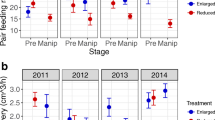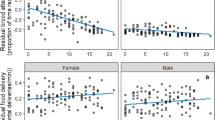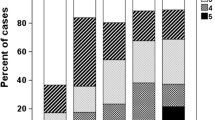Abstract
In long-lived species, behaviour is expected to vary across the lifespan, first improving with maturation and experience and then declining with senescence, but measurement is rare, particularly during old age. Measuring nest defence intensity in 255 known-age blue-footed boobies (Sula nebouxii) of 19 age classes confirmed the inverted-U pattern: intensity of nest defence increased in young males and females until roughly 11–12 years and declined progressively afterwards. We discuss the processes that may generate this distinctive pattern. Regardless of the underlying processes, this study establishes the existence of age-related variation in parental care in a long-lived species. Natural variation in natal conditions has recently been shown to have long-term impacts on development, so this study raises the question whether age-related changes in parental care generate systematic variation in offspring phenotypes.
Significance statement
In theory, age-related change in parental care can result in differences among offspring produced at different ages. However, parental behaviour has never been measured over the whole age-span of any long-lived species because of the difficulty of sampling very old animals in the field. We measured intensity of nest defence over the age-span and confirmed that blue-footed boobies exhibit an age-related quadratic pattern in this parental behaviour: defence intensity increases in early life and declines progressively afterwards. Our results imply that similar-shaped patterns may exist in other components of parental care, such as feeding and social interaction, potentially affecting the long-term development of offspring.

Similar content being viewed by others

References
Ancona S, Sánchez-Colón S, Rodríguez C, Drummond H (2011) El Niño in the warm tropics: local sea temperature predicts breeding parameters and growth of blue-footed boobies. J Anim Ecol 80:799–808
Angelier F, Moe B, Weimerskirch H, Chastel O (2007) Age-specific reproductive success in a long-lived bird: do older parents resist stress better? J Anim Ecol 76:1181–1191
Bartón K (2016) Multi-model inference. R package version 1.15.6, https: //CRAN.R-project.org/package=MuMIn
Bates D, Maechler Martin, Walker S (2016) Package “lme4”: linear mixed-effects models using “Eigen” and S4, https://github.com/lme4/lme4/ http://lme4.r-forge.r-project.org/
Beamonte-Barrientos R, Velando A, Drummond H, Torres R (2010) Senescence of maternal effects—aging influences egg quality and rearing capacities of a long-lived bird. Am Nat 175:469–470
Berman M, Gaillard J-M, Weimerskirch H (2009) Contrasted patterns of age-specific reproduction in long-lived seabirds. Proc R Soc Lond B 276:375–382
Brunton D (1990) The effects of nesting stage, sex, and type of predator on parental defense by killdeer (Charadrius vociferous): testing models of avian parental defense. Behav Ecol Sociobiol 26:181–190
Burnham KP, Anderson DR (2002) Model selection and multi-model inference: a practical information-theoretic approach, 2nd edn. Springer, New York
Burnham KP, Anderson DR, Huyvaert KP (2011) AIC model selection and multimodel inference in behavioral ecology: some background, observations, and comparisons. Behav Ecol Sociobiol 65:23–35
Cade BS (2015) Model averaging and muddled multimodel inferences. Ecology 96:2370–2382
Clutton-Brock TH (1984) Reproductive effort and terminal investment in iteroparous animals. Am Nat 123:212–229
CONANP (2005) Programa de conservación y manejo del Parque Nacional Isla Isabel. Conanp-Semarnat, México
Douhard M, Loe LE, Stien A, Bonenfant C, Irvine RJ, Veiberg V, Ropstad E, Steve Albon S (2016) The influence of weather conditions during gestation on life histories in a wild Arctic ungulate. Proc R Soc B 283:20161760
Drummond H, Ancona S (2015) Observational field studies reveal wild birds responding to early-life stresses with resilience, plasticity, and intergenerational effects. Auk 132:563–576
Drummond H, Rodríguez C (2015) Viability of booby offspring is maximized by having one young parent and one old parent. PLoS One 10:e0133213
Ericsson G, Wallin K, Ball JP, Broberg M (2001) Age-related reproductive effort and senescence in free-ranging moose, Alces alces. Ecology 82:1613–1620
Forslund P, Pärt T (1995) Age and reproduction in birds—hypotheses and tests. Trends Ecol Evol 10:374–378
Gelman A, Su Y-S, Yajima M, Hill J, Pittau MG, Kerman J, Zheng T, Dorie V (2016) Data analysis using regression and multilevel/hierarchical models, https://cran.r-project.org/web/packages/arm/index.html
Greig-Smith PW (1980) Parental investment in nest defence by stonechats (Saxicola torquata). Anim Behav 28:604–619
Grueber CE, Nakagawa S, Laws RJ, Jamieson IG (2011) Multimodel inference in ecology and evolution: challenges and solutions. J Evol Biol 24:699–711
Hamer KC, Furness RW (1991) Age-specific breeding performance and reproductive effort in Great Skuas Catharacta skua. J Anim Ecol 60:693–704
Jones OR, Gaillard J-M, Tuljapurkar S et al (2008) Senescence rates are determined by ranking on the fast-slow life-history continuum. Ecol Lett 11:664–673
McCleery RH, Perrins CM, Sheldon BC, Charmantier A (2008) Age-specific reproduction in a long-lived species: the combined effects of senescence and individual quality. Proc R Soc Lond B 275:963–970
McNamara JM, Houston AI, Barta Z, Scheuerlein A, Fromhage L (2009) Deterioration, death and the evolution of reproductive restraint in late life. Proc R Soc Lond B 276:4061–4066
Nelson JB (1978) The Sulidae: gannets and boobies. Oxford University Press, Oxford
Nussey DH, Kruuk LEB, Morris A, Clutton-brock TH (2007) Environmental conditions in early life influence ageing rates in a wild population of red deer. Curr Biol 17:1000–1001
Preston BT, Saint Jalme M, Hingrat Y, Lacroix F, Sorci G (2015) The sperm of aging male bustards retards their offspring’s development. Nat Commun 6:6146
Pugesek BH (1983) The relationship between parental age and reproductive effort in the California Gull (Larus californicus). Behav Ecol Sociobiol 13:161–171
Development Core Team R (2017) R: a language and environment for statistical computing. R Foundation for Statistical Computing, Vienna, Austria http://www.R-project.org/
Robertson RJ, Rendell WB (2001) A long-term study of reproductive performance in tree swallows: the influence of age and senescence on output. J Anim Ecol 70:1014–1031
Sánchez-Macouzet O, Drummond H (2011) Sibling bullying during infancy does not make wimpy adults. Biol Lett 7:869–871
Stearns SC (2000) Life history evolution: successes, limitations, and prospects. Naturwissenschaften 87:476–486
Torres R, Drummond H, Velando A (2011) Parental age and lifespan influence offspring recruitment: a long-term study in a seabird. PLoS One 6:e27245
Velando A, Drummond H, Torres R (2006) Senescent birds redouble reproductive effort when ill: confirmation of the terminal investment hypothesis. Proc R Soc Lond B 273:1443–1448
Acknowledgements
We thank numerous volunteers for enthusiastic work in the field and on the database; Alejandro Gonzalez and Lynna Kiere for statistical advice; and the Armada de México, staff of SEMARNAT and local fishermen for logistical support. For comments on the manuscript, we thank Sergio Ancona, Péter Szenczi and Oxána Bánszegi, as well as two anonymous reviewers.
Funding information
This study was funded by Universidad Nacional Autónoma de México (PAPIIT grant IN205313).
Author information
Authors and Affiliations
Corresponding author
Ethics declarations
Conflict of interest
The authors declare that they have no conflict of interest.
Ethical approval
All applicable international, national and/or institutional guidelines for the care and use of animals were followed. The Secretaría de Medio Ambiente y Recursos Naturales (SEMARNAT) provided the permit for this study (SGPA/DGVS/10856/13).
Additional information
Communicated by J. A. Graves
Data availability
All data generated or analysed during this study are included in this published article and its supplementary information files.
Rights and permissions
About this article
Cite this article
Ortega, S., Sánchez-Macouzet, O., Urrutia, A. et al. Age-related parental care in a long-lived bird: implications for offspring development. Behav Ecol Sociobiol 71, 132 (2017). https://doi.org/10.1007/s00265-017-2364-7
Received:
Revised:
Accepted:
Published:
DOI: https://doi.org/10.1007/s00265-017-2364-7



